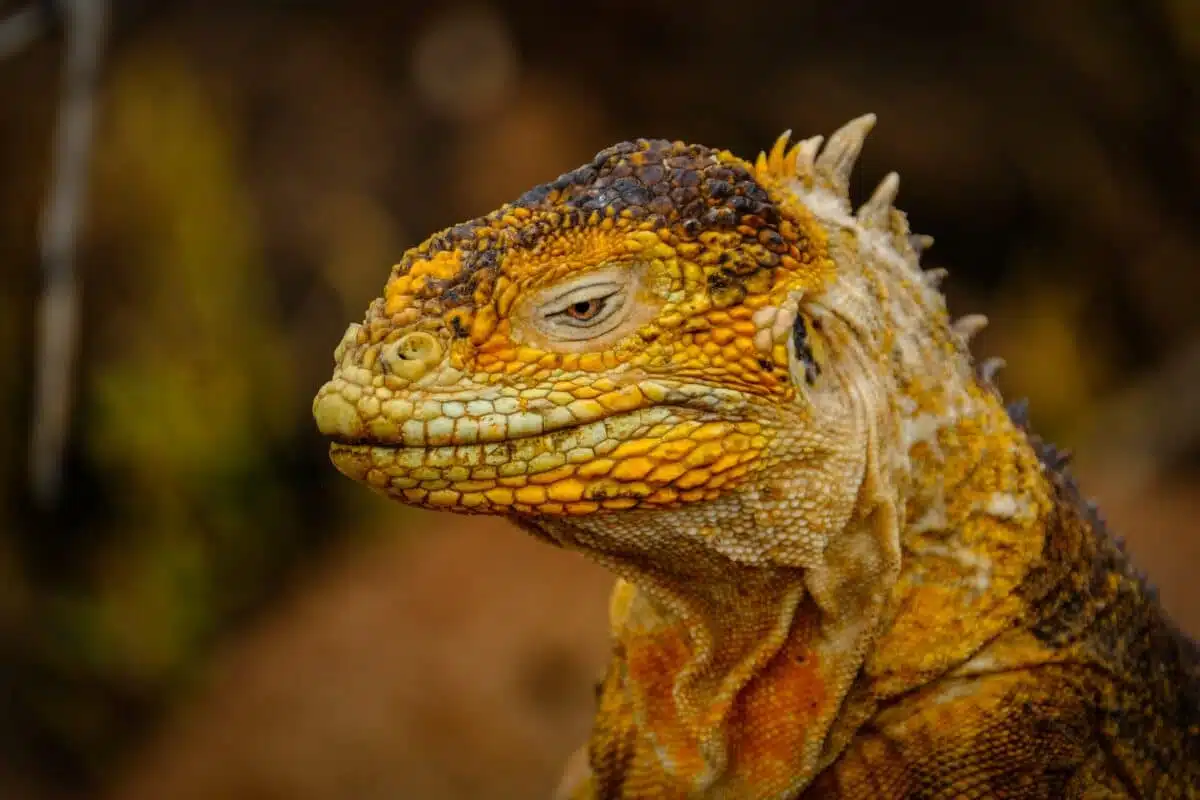Are you a lizard-lover? Then you will also love this extensive list of different types of lizards from all the corners of our planet.
Earth is home to organisms of diverse forms, sizes, and shapes. Some of these creatures share the same habitat and encounter each other. In contrast, others prefer solace and live peacefully away from the densely populated regions.
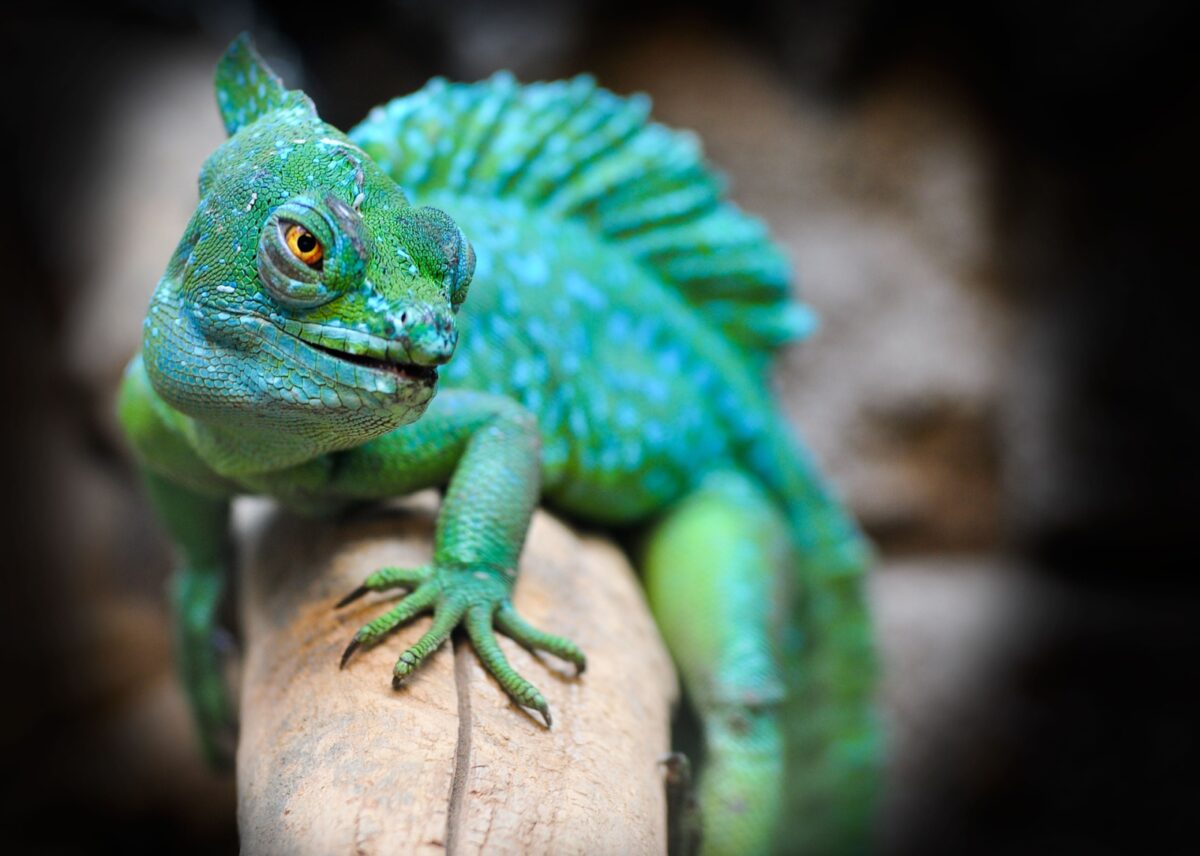
What comes to everybody’s mind when they hear the word lizard? Maybe the only ones we all are familiar with is the common house gecko or Hemidactylus frenatus. In line with mother nature’s impressive diversity, there is a plethora of different types of lizards. Some look alike, whereas others have a distinct physical form with hardly any resemblance to their family.
Researchers and biologists with a keen interest in the study of reptiles go the extra mile to identify, learn, and explore the universe of lizards in order to make a treasure of knowledge.
In this post, you will find detailed information about the family of lizards, their habitat, characteristics, and similarities.
What Are Lizards?
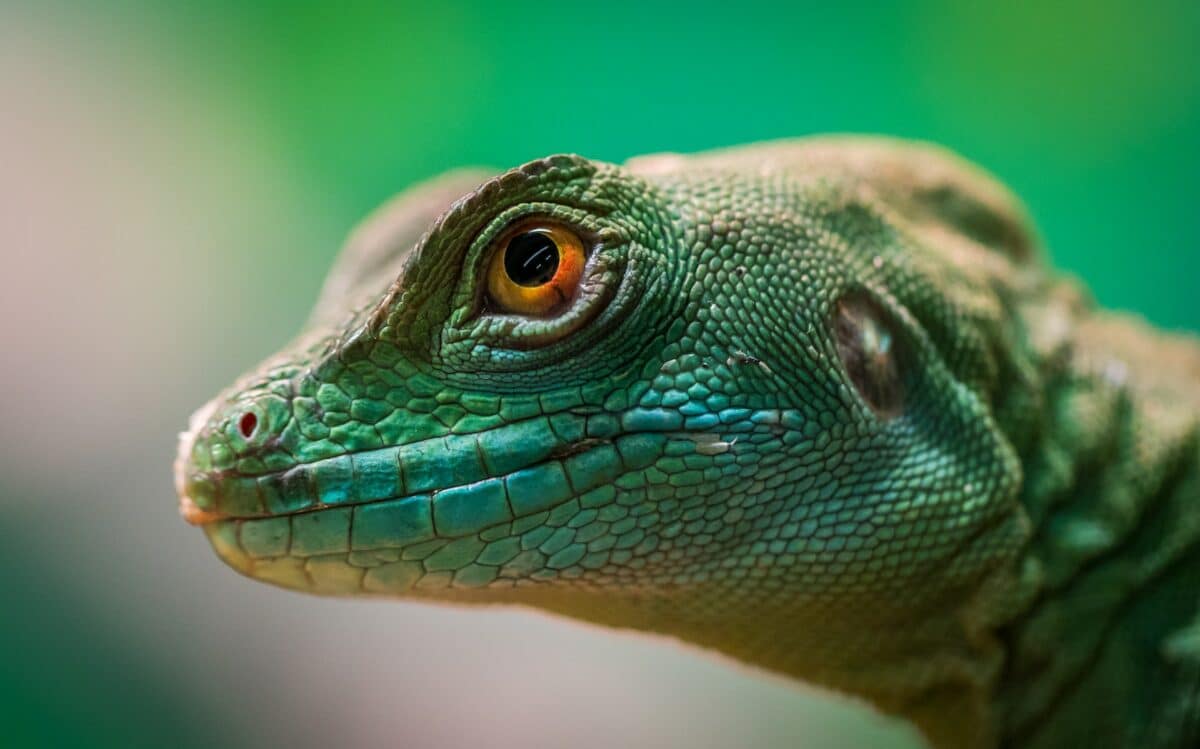
Lizards belong to a class of animals referred to as “reptiles,” which are very closely associated with snakes. About 200 million years ago, the ancestors of lizards appeared on earth. Also, according to some beliefs, many types of lizards of the modern age bear a resemblance to the prehistoric reptiles that existed in the dinosaur era.
Generally, lizards are animals with scales-covered bodies instead of skin, along with a minimal head, elongated body, pointed tail, and movable eyelids. Owing to their distinctive appearance and widespread existence, they are considered to be easily identifiable creatures. But exact names, natures, and in-depth details about their families are unknown to the average person.
Reproduction
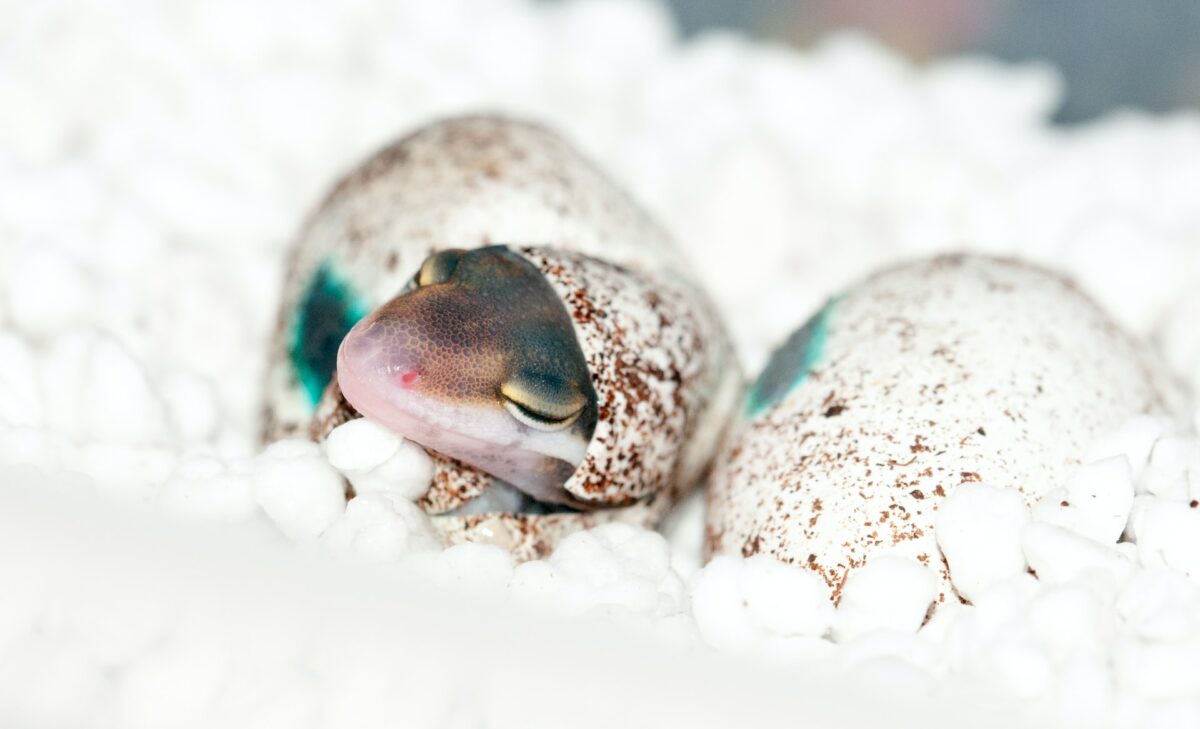
They reproduce by laying eggs, whereas offspring of some species grow inside the mother. The female lizards lay eggs that are soft and leathery in texture. It is also interesting to learn that after laying the eggs, female lizards don’t remain around to shield and shelter them from damage and injury – not even to keep the eggs warm.
The newly born lizards are capable of taking care of themselves independently right after they hatch.
Habitat
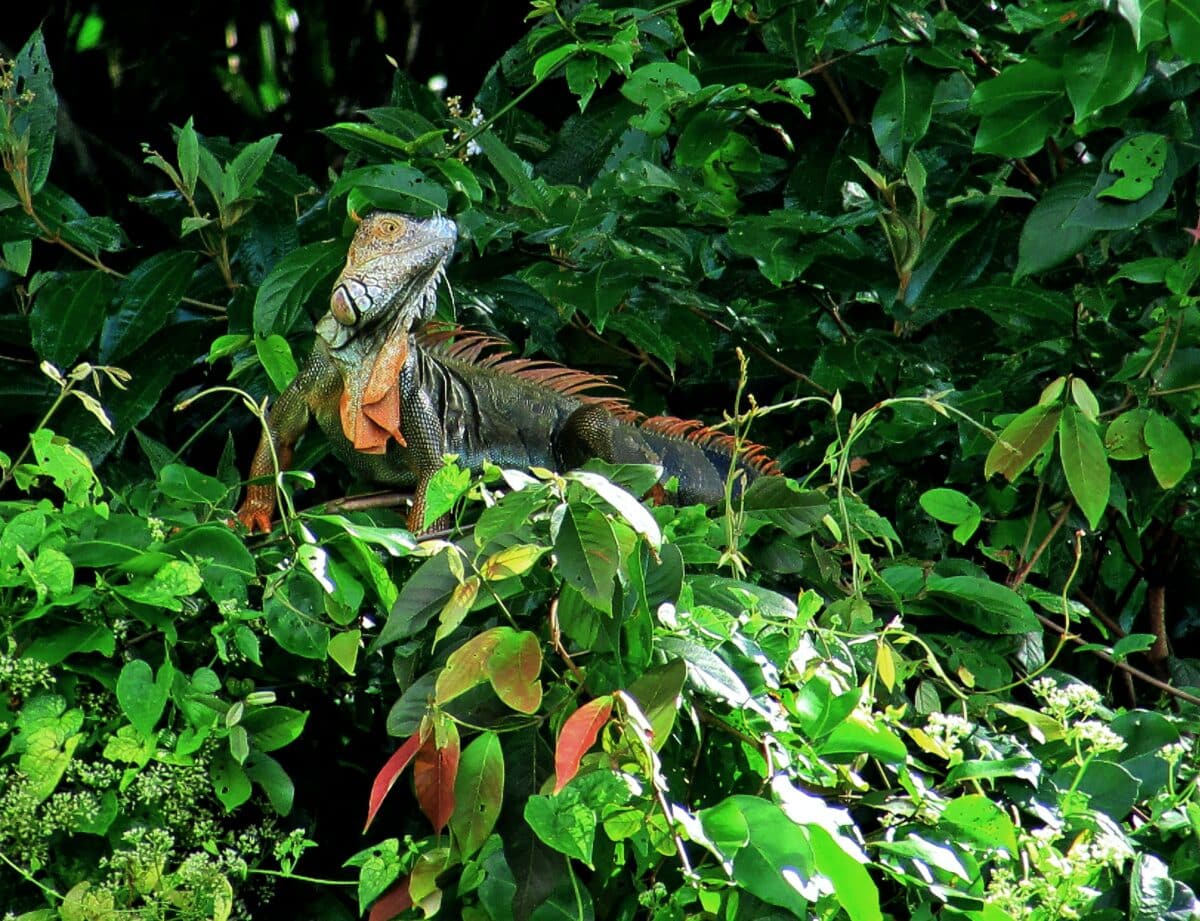
Lizards inhabit forests, woodlands, rocky topographies, and deserts of the entire globe, with the sole exception of Antarctica. Lizards are cold-blooded animals, hence they are energetic throughout the day until they attain warmth to their bodies from the sun.
Generally, they are anti-social animals, with the exception of the mating phase. At this time, you can spot the females and males relaxing together. The exemption to the conventional living lizards is the desert night lizards, who are seen active during the night and prefer living in groups or communities of their family members.
Interesting Trait
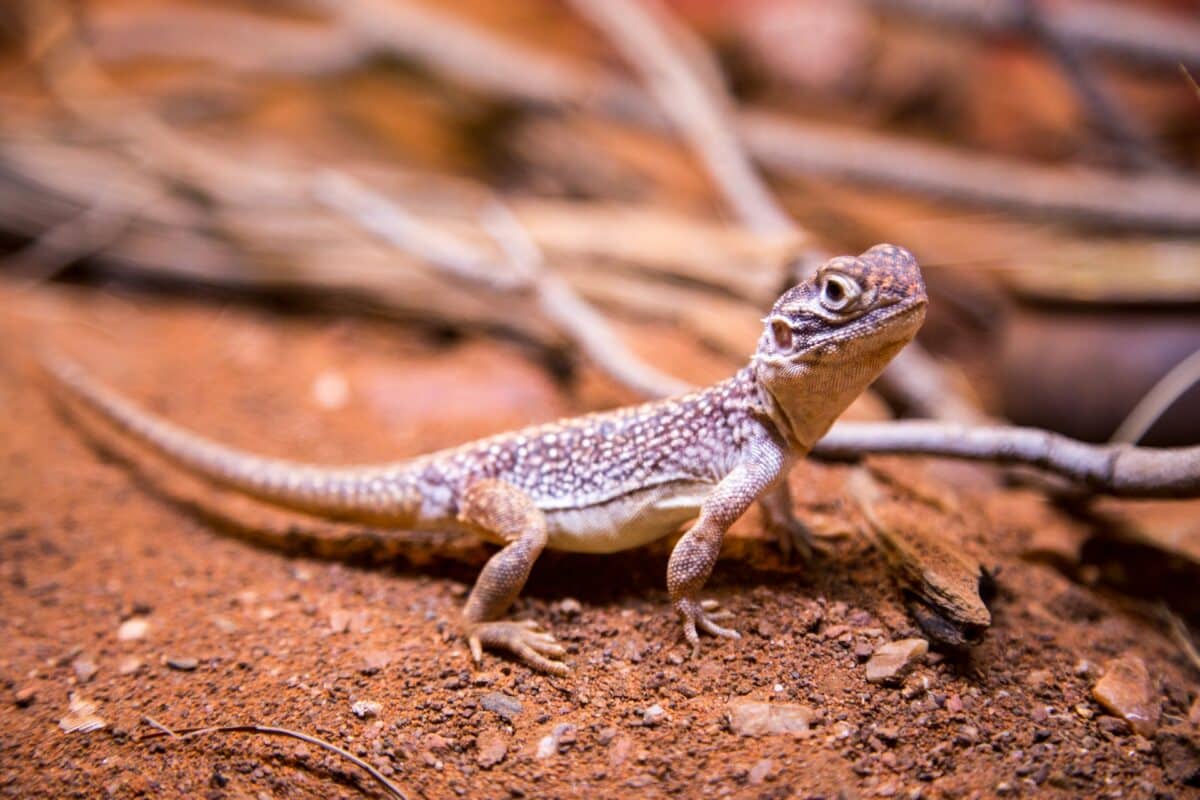
One interesting trait owned by lizards is their capability to regenerate broken tails. They have a mechanism of puzzling their predators by purposely dropping sections of their tails when encountered with danger or grabbed. After they drop their tail, it remains “alive”, twisting and flopping with life. This trick gives the lizard a safe window to escape when the predator focuses on their flopping tail.
Types of Lizards
If the entire world is assessed, some 6,000 different types of lizards are distributed across the globe. Lizards comprise 40 diverse families exhibiting an incredible assortment of colors, physical features, and dimensions.
Like all reptiles, lizards have dry and parched skin owing to the lack of pores to eliminate water and oils. But at times, in some lizards, their skin exhibits a smooth form, making them appear as slimy or glassy.
The chief families comprise iguanas, chameleons, girdled lizards, agamids, crocodile lizards, night lizards, alligator lizards, plated lizards, basilisks, skinks, tegus and greaved lizards, monitor lizards, earless monitor, and the typical lizards.
It is impossible to name and list each lizard living on this earth, but some of the interesting types of lizards are detailed below:
#1 Thorny Dragon or Moloch Horridus
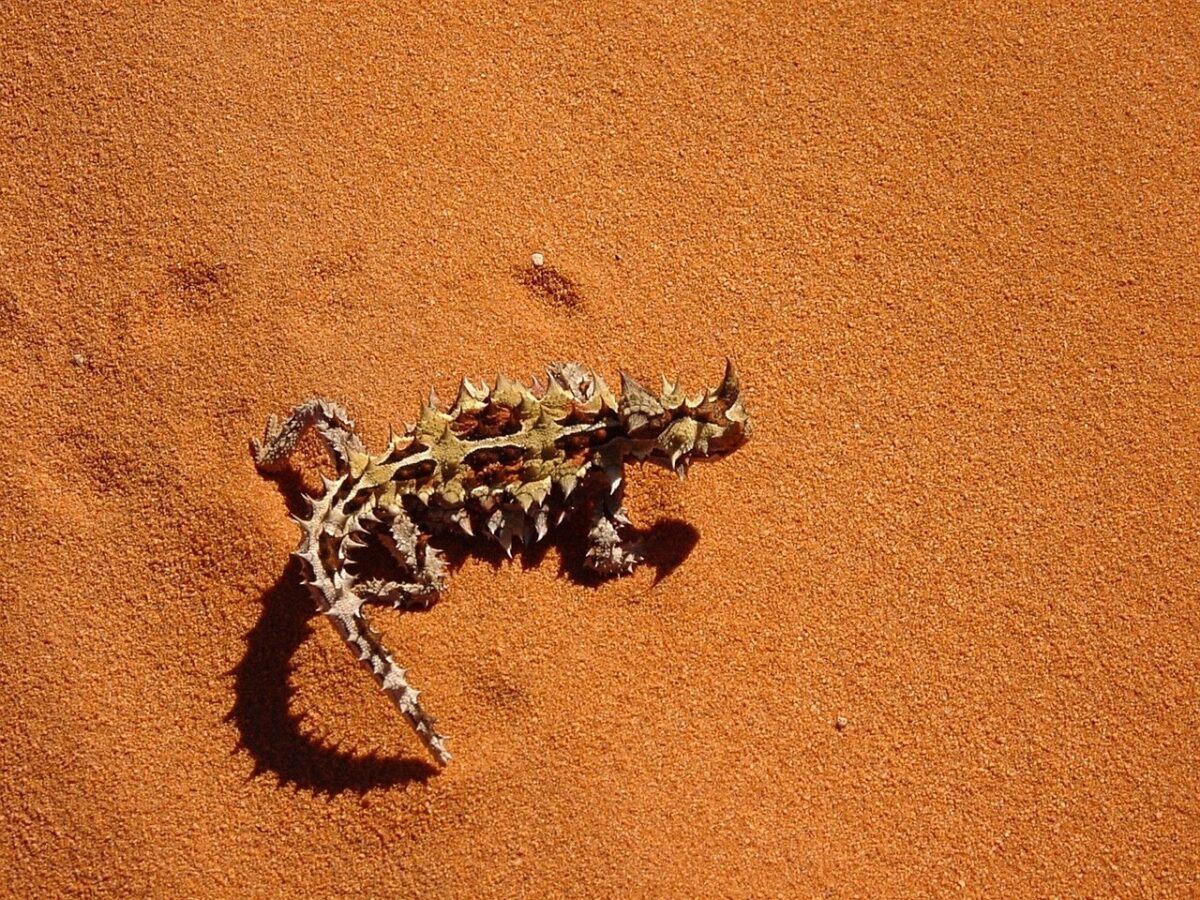
Thorny Dragon or Moloch horridus, also known by the name of mountain devil and thorny devil, is an equitably hefty lizard inhabiting all over central and western Australia.
The spiky scales and the typical petrifying name make it very intimidating. Still, in reality, it’s a very lazy lizard that strolls around, feeding on ants. The fear-provoking thorny dragon has an estimated life span of about 20 years.
#2 Jackson’s Chameleon or Trioceros Jacksonii
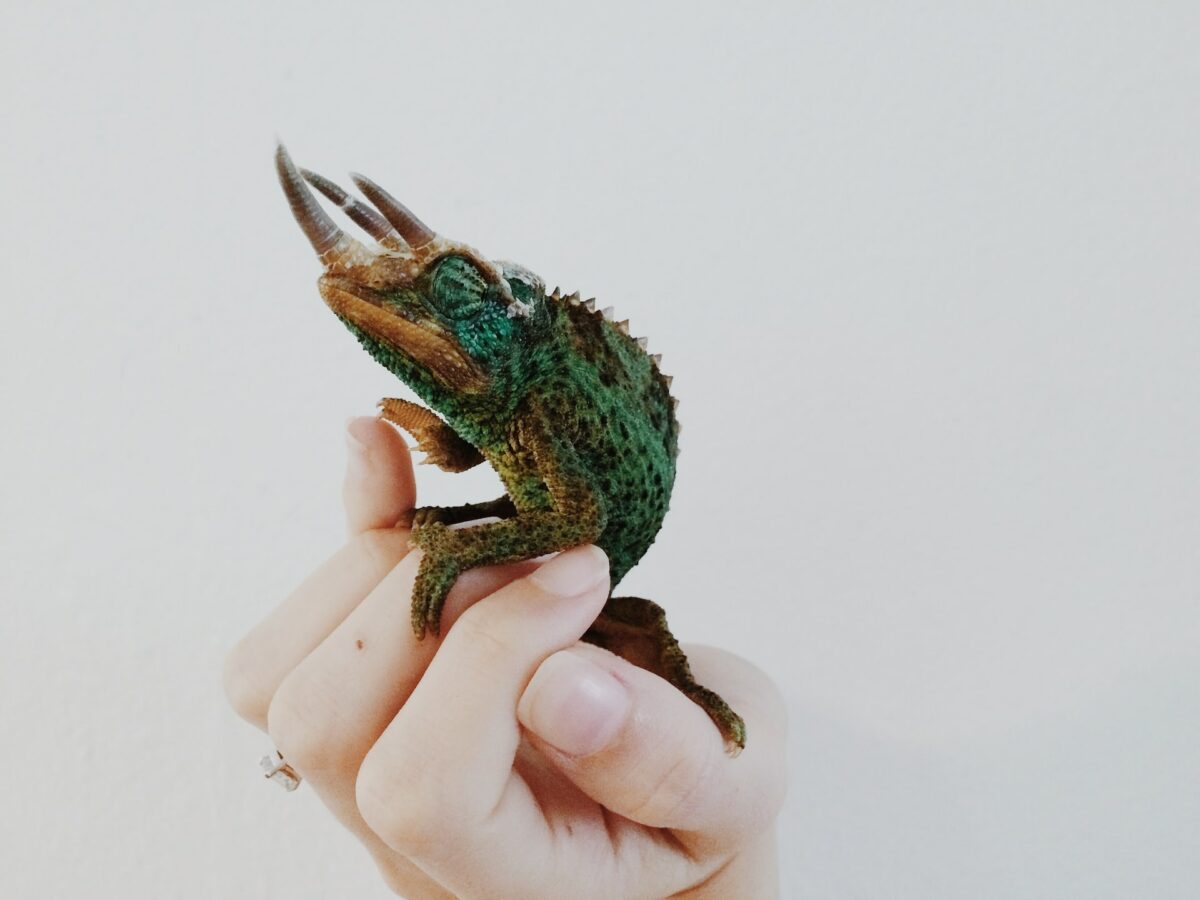
Jackson’s Chameleon or Trioceros Jacksonii is a well-known native of East African forests, which later entered California, Hawaii, and Florida. It has a very interesting appearance of three horns, making it resemble the Triceratops dinosaur.
As known with chameleons, they are capable of changing colors depending on the external environment’s weather or their temperamental changes. Their diet comprises insects, small birds, and even other lizards.
#3 Satanic Leaf-Tailed Gecko or Uroplatus Phantasticus
The Satanic Leaf-Tailed Gecko, or Uroplatus Phantasticus, is an eastern Madagascar inhabitant that undoubtedly holds a petrifying name. But it isn’t as creepy as evident by its name. Their bodies are brown in color, with a distinct leaf-shaped tail, hence the name.
#4 Tokay Gecko or Gekko Gecko
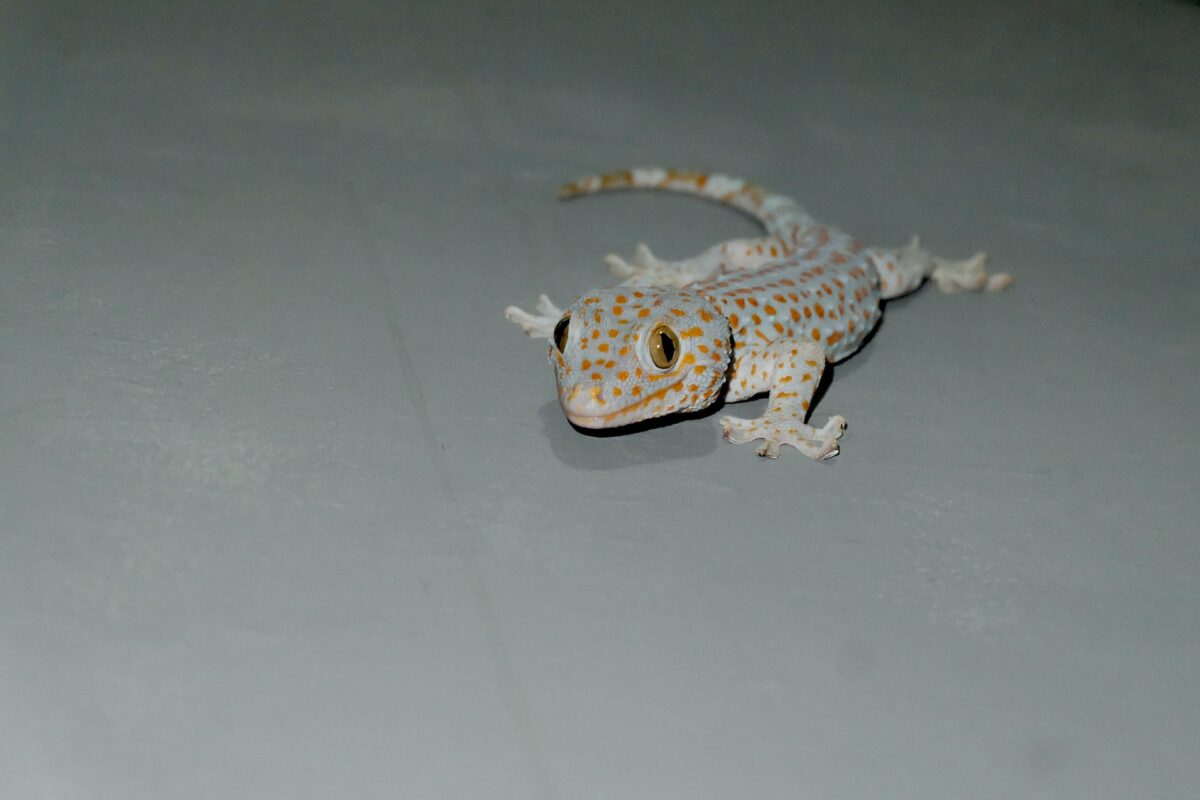
Tokay Gecko or Gekko Gecko are southern and East Asian inhabitants, known for their distinctive length as they can grow up to 16 inches. These lizards are either have red spots or black spots. They are solitary creatures who prefer being alone and are also nocturnal, meaning staying active at night.
#5 Argentine Black and White Tegu or Salvator Merianae
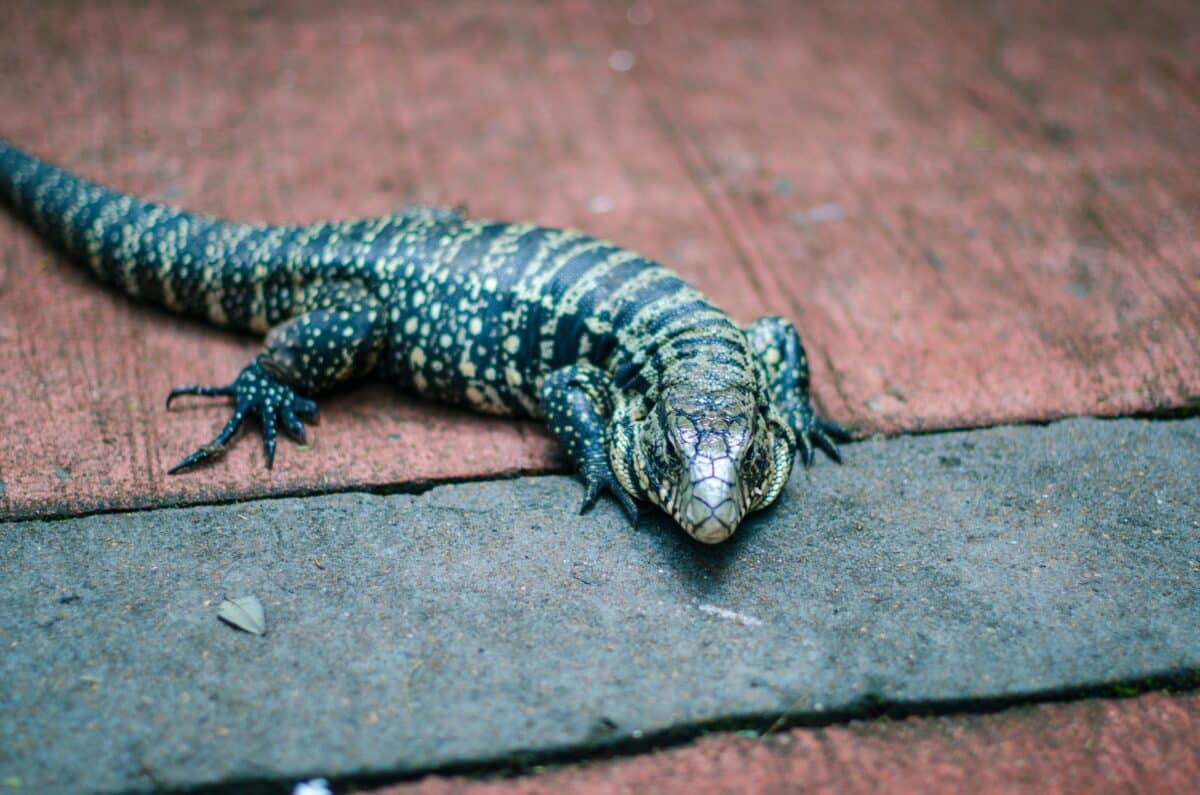
Argentine Black and White Tegu, or Salvator Merianae, inhabit almost all regions of Argentina, Uruguay, Paraguay, and parts of Brazil. They are pretty large in size and can grow up to lengths of about 4 feet.
These lizards are easily identifiable owing to their characteristic black and white bands throughout their tail. They feed on rats, small lizards, fruits, vegetables, and animal eggs.
#6 Galápagos Land Iguana or Conolophus Subcristatus
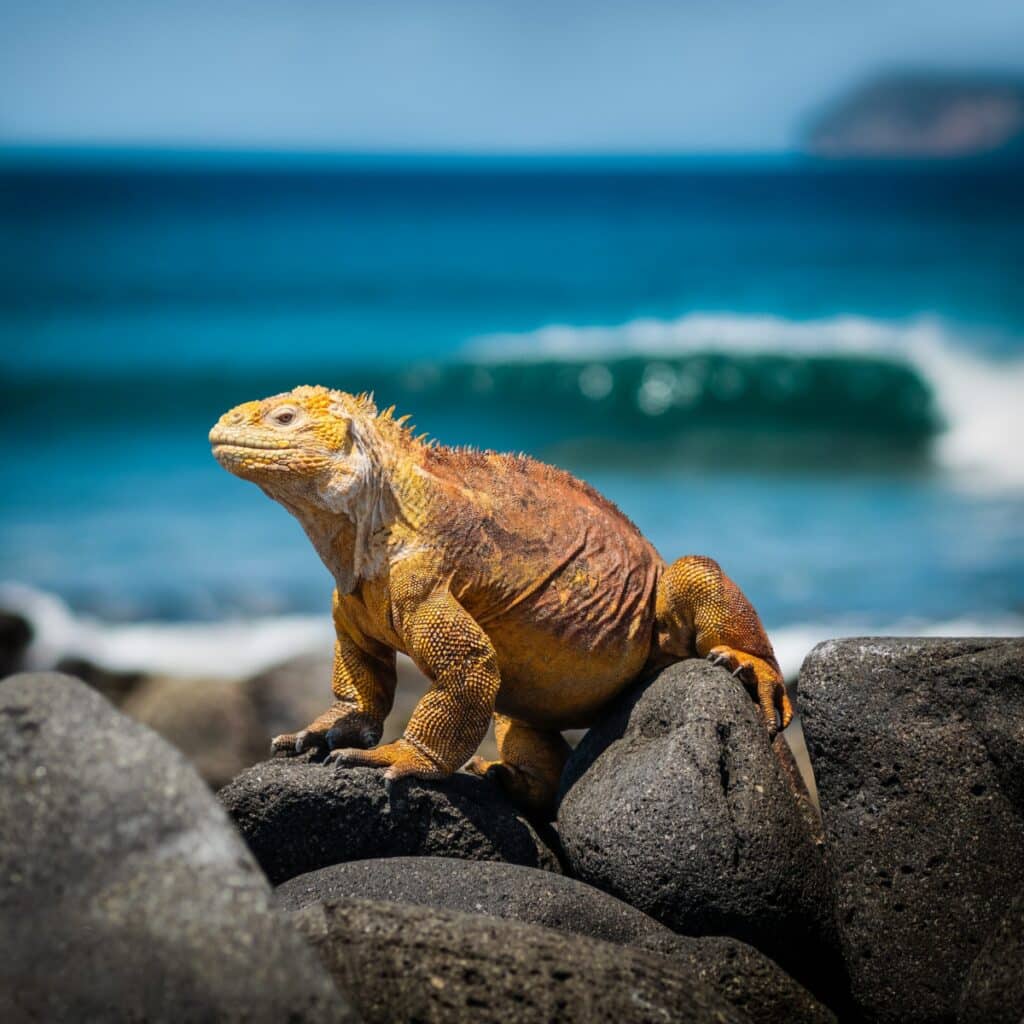
Galápagos Land Iguana, or Conolophus Subcristatus, is a beautiful yellow creature residing on the Galapagos Islands. These lizards have a life span of about 55 years. They have a mutualistic relationship with local finches. It is a common sight to see finches riding on their backs and picking ticks buried in their scales.
#7 Fiji Crested Iguana or Brachylophus Vitiensis
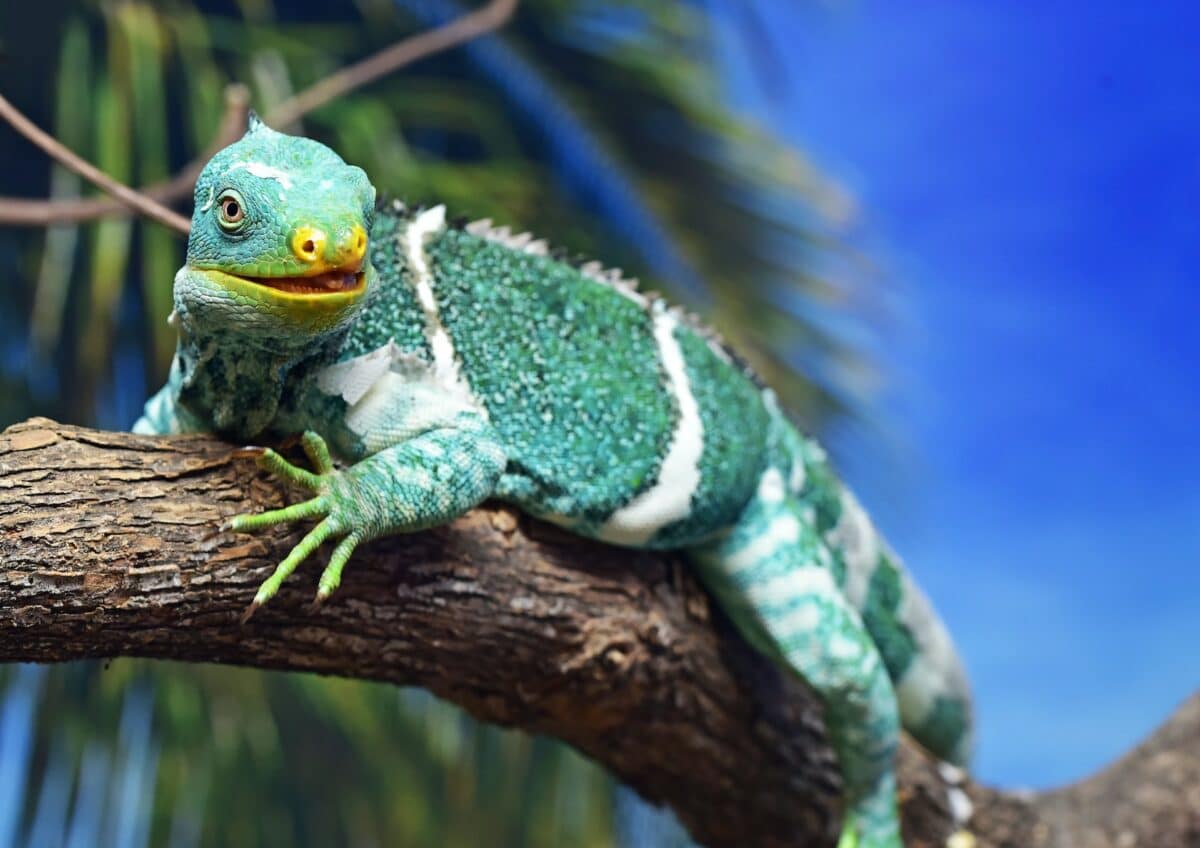
Fiji Crested Iguana, also known as Brachylophus Vitiensis, are rare inhabitants of the Fiji Islands who prefer living in forested territories. As soon as they hatch, they are dark green. Soon thereafter, their color changes and evolves to a darker green until they become adults.
These lizards are very easily identifiable owing to their distinct green head and body covered with white bands.
#8 Marine Iguana or Amblyrhynchus Cristatus
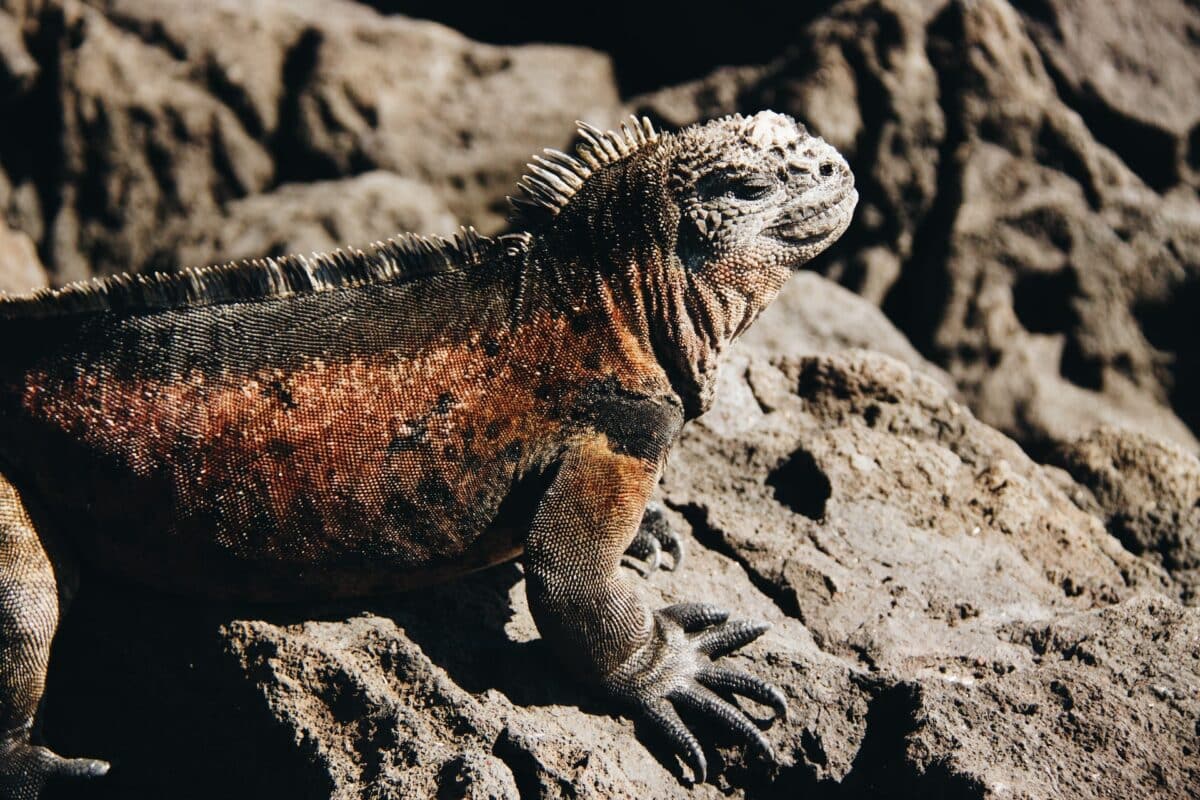
Marine Iguana or Amblyrhynchus Cristatus are the only lizards that like spending time swimming in the ocean and feeding off algae. The Galapagos Islands are home to these species. They have large bodies reaching up to 4.3 feet.
#9 Green Basilisk or Basiliscus Plumifrons
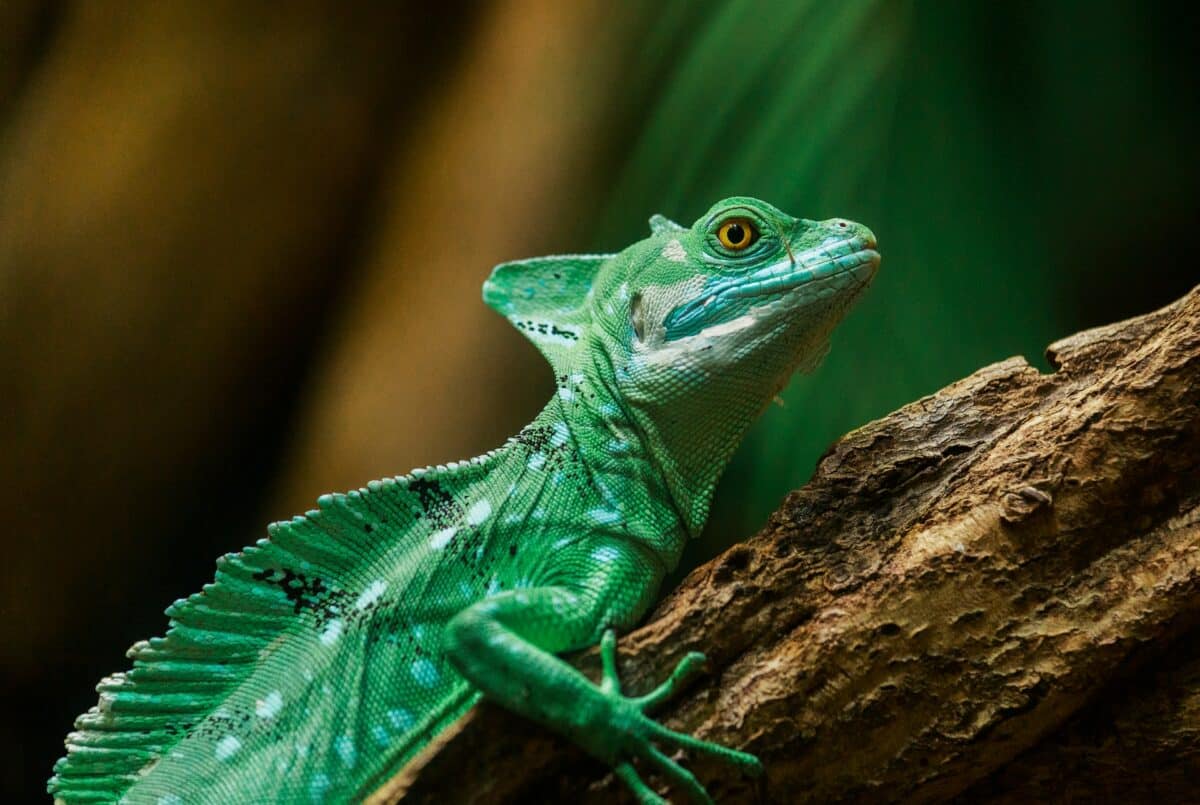
Green Basilisk or Basiliscus Plumifrons is a beautiful inhabitant of tropical rainforests of Panama, Nicaragua, Costa Rica, and Honduras. These lizards are bright green colored with an enormous crest attached to their heads and a long spiny plate running along their backs.
These distinctive features make them easily identifiable in comparison with other species.
#10 Slow Worm or Anguis Fragilis
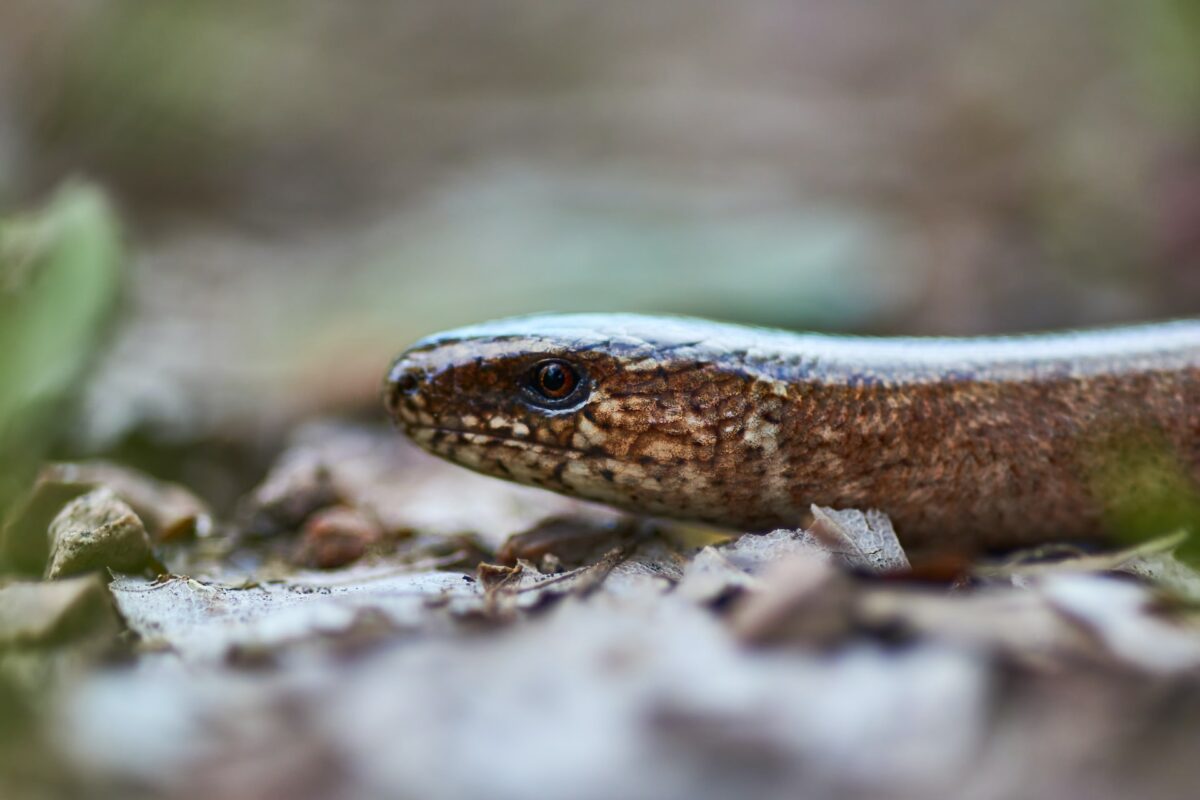
Slow Worm or Anguis Fragilis is an elongated snake-like animal. In actuality, it’s a lizard. The best explanation for this species is that it is a legless lizard. The reasons that distinguish them from snakes and worms are their ability to blink their eyelids and their ability to drop their tail.
They are non-aggressive and non-venomous lizards commonly found hanging around home gardens in the United Kingdom and Ireland.
#11 Northern Blue Tongue Skink or Tiliqua Scincoides Intermedia
Northern Blue Tongue Skink or Tiliqua Scincoides Intermedia is a well-known inhabitant of New Guinea and Northeastern Australia, owing to its distinct blue tongue. They are an ovoviviparous species, meaning they don’t lay eggs but rather retain them inside their bodies and give birth to the young after they hatch.
These lizards are about 15 inches long with heavy and broad bodies.
#12 Armadillo Girdled Lizard or Ouroborus Cataphractus
Armadillo Girdled Lizard or Ouroborus Cataphractus is a small lizard that lives in Southern Africa. It has this interesting name owing to its remarkable scales and curved tail resembling that of an armadillo. The life span of these lizards is about 25 years.
Contrary to the nature of its fellow species, Armadillo Girdled Lizards are very social, preferring to live in communities of about 60 companions.
#13 Kuhl’s Flying Gecko or Gekko Kuhli
Kuhl’s Flying Gecko, or Gekko Kuhli, is a charming category of lizard with a cool design and form with a relatively small body. It has broad and flat webbed feet, making it distinguishable and providing strong camouflage.
These lizards are inhabitants of Southern Thailand, Northern India, Myanmar, Indonesia, and the Malaysian Peninsula. Interestingly this species is very popular among people as pets.
#14 Perentie Monitor or Varanus Giganteus
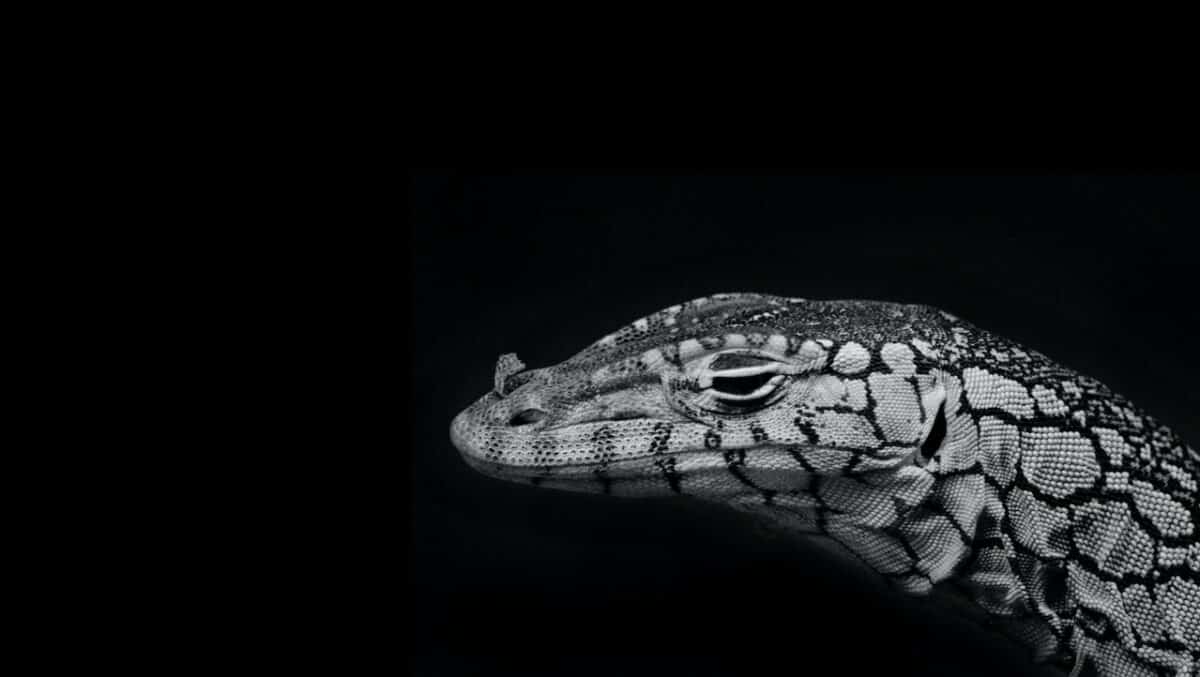
Perentie Monitor, or Varanus Giganteus, is one of the fastest species inhabiting central and Western Australia. They are almost 2 meters long. These lizards are carnivores meaning they feed on small and larger mammals, other lizards, and birds.
#15 Mexican Alligator Lizard or Abronia Graminea
Mexican Alligator Lizard, or Abronia Graminea, comes in bright colors and reside in Veracruz and Puebla in Mexico. They received their name because they resemble alligators, especially from a distance.
These lizards have distinctly triangular heads coupled with green bodies and particularly yellow bellies. These lizards possess a grasping tail which they use to climb trees.
#16 Rhinoceros Iguana
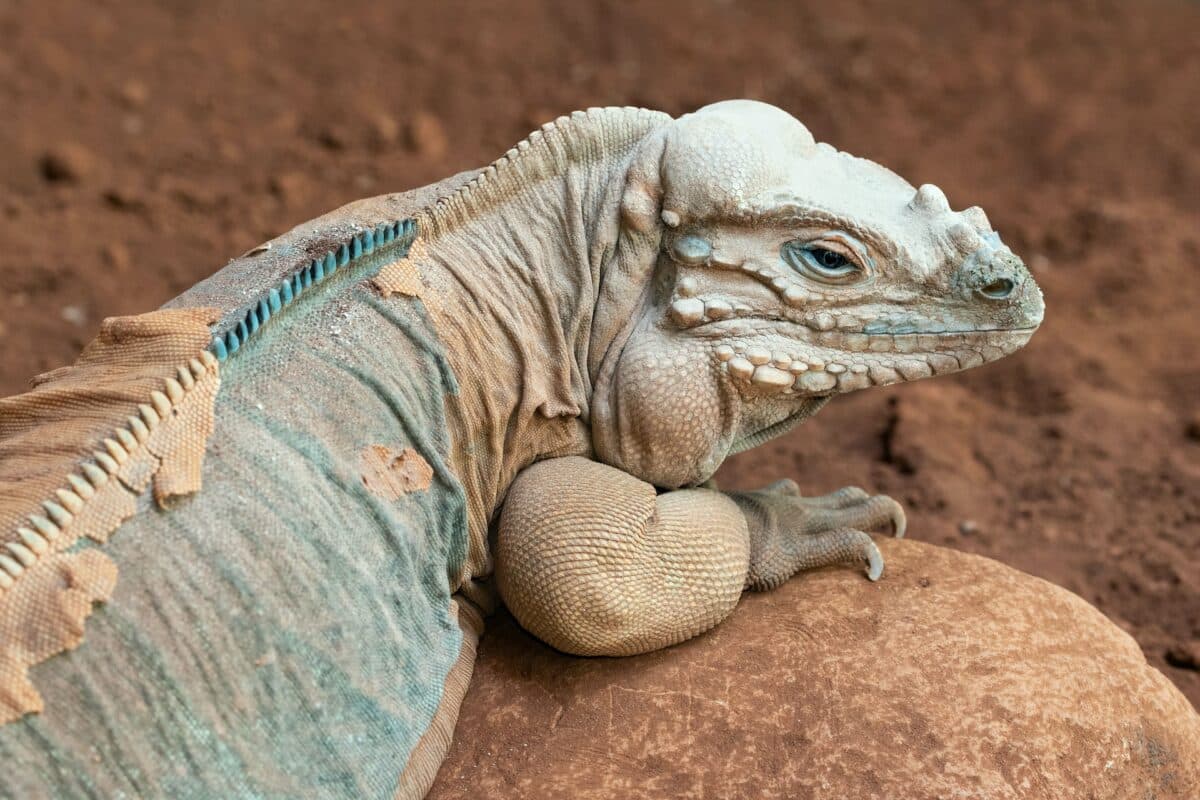
Rhinoceros Iguana inhabits the Caribbean, predominantly the island of Hispaniola. They are olive-grey colored and have a distinctive set of horns positioned on its nose and a splendid pattern of spikes running across their spine, through and through to the tip of their tail.
#17 Common Leopard Gecko or Eublepharis Macularius

Common Leopard Gecko or Eublepharis Macularius is a small lizard of about 11 inches, found in Iran, Iraq, and Afghanistan. These lizards can feed on anything and everything.
Their reproduction is temperature-dependent sex determination, meaning that the gender of leopard gecko offspring depends on the temperature of the external surroundings during gestation. Interestingly the females are conceived in cool environments, whereas the males are conceived in warm environments.
#18 Mwanza Flat-Headed Rock Agama or Agama Mwanzae
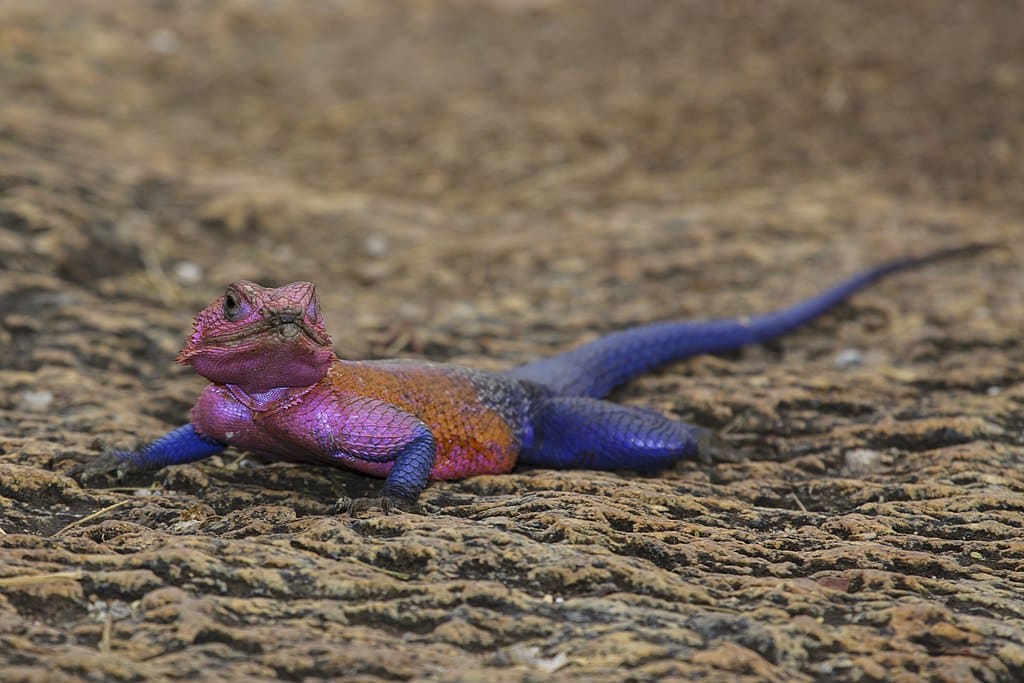
Mwanza Flat-Headed Rock Agama, or Agama Mwanzae, is a small lizard with a typical flat head. The males of this species are popularly known by the name “Spider-man Agama” owing to their bright pink and blue colored body, greatly resembling the fictional character.
The female counterparts are brownish in color. They are popular East African inhabitants and their favorite foods include ants and plants.
Rare and Endangered Types of Lizards
Lizards also suffer from endangerment, similar to other reptiles. All of it is because of the amalgamation of various factors, including habitat demolition, climate change, predation, and the prevalent issue of the illegal pet trade.
Listed below are some of the threatened types of lizards:
#1 Gargoyle Gecko or Rhacodactylus Auriculatus
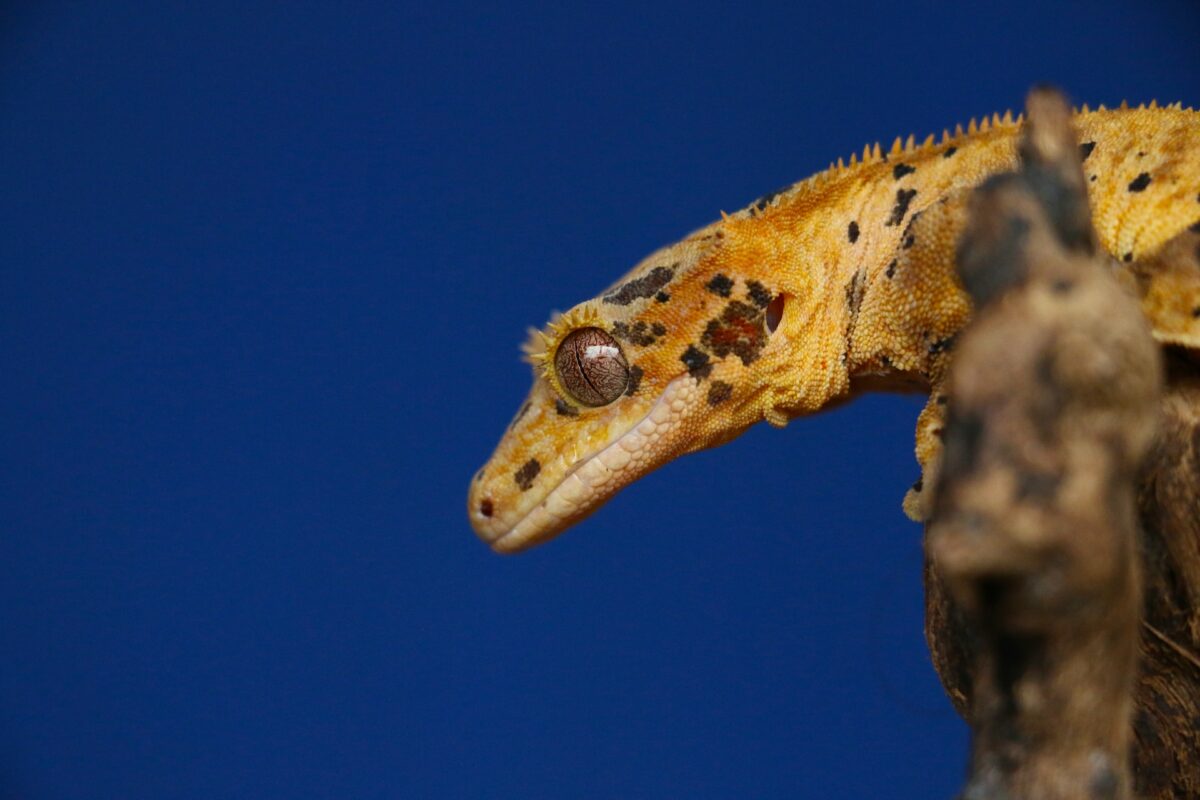
Gargoyle Gecko, or Rhacodactylus Auriculatus, inhabits the southern parts of New Caledonia and the East of Australia. They have small bodies and are known to be pretty good climbers but, sadly, are endangered.
#2 Guatemalan Beaded Lizard or Heloderma Charlesbogerti
Guatemalan Beaded Lizards, or Heloderma Charlesbogerti, are endemic to a desert in the East of Guatemala. It is closely related to the type of lizards known by the name Gila monster. Guatemalan Beaded Lizards are deemed critically threatened, with just 200 lizards left in the world.
#3 Psychedelic Rock Gecko or Cnemaspis Psychedelica
Psychedelic Rock Gecko or Cnemaspis Psychedelica is a popular lizard only limited to two Vietnamese Islands named Hon Khoai and Hon Tuong. It faces endangerment because it is a beloved species of the pet industry, often involved in illegal wildlife trafficking. The lizard has interesting color combinations of yellow, orange, and a golden hue.
#4 Hidden Dragon or Cryptagama Aurita
Hidden Dragon or Cryptagama Aurita is limited to the Kimberley region of Western Australia. Physically they appear just like a rock. As the species faces endangerment, a lot of efforts are being directed toward studying its habitat preservation.
#5 Culebra Island Giant Anole or Anolis Rooseveltii
Culebra Island Giant Anole, or Anolis Rooseveltii, was first found on Culebra Island, located in the Caribbean. Later on, similar species were spotted on Tortola Island and, lastly, St. John in the United States Virgin Islands.
#6 Blue Tree Monitor or Varanus Macraei
Blue Tree Monitor, or Varanus Macraei, is a very recently discovered species first found in the year 2001. They are endemic to the Indonesian island of Batanta. It is a favorite for the illegal pet trade owing to its attractive blue color, thus leading to its extinction.
#7 Galapagos Pink Land Iguana or Conolophus Marthae
Galapagos Pink Land Iguana, or Conolophus Marthae, is a very beautiful and attractive lizard with rosy pink and dark bands. They can only be found in Wolf Volcano on Northern Isabella Island in Galapagos.
According to studies, there are only 200 lizards of this species left in the world, making them critically endangered.
#8 Chinese Crocodile lizard or Shinisaurus Crocodilurus
The Chinese Crocodile lizard, or Shinisaurus Crocodilurus, is also one of the severely endangered species, with just 1000 lizards left in the world. It is known for its sleeping behavior, laying still and sleeping for several hours, earning it the legendary name of “the lizard of great sleepiness.” It is believed to be the cure for insomnia and hence faces endangerment.
#9 Ricord’s Rock Iguana
Ricord’s Rock Iguana is a critically endangered species of Hispaniola Island, with merely 2500 lizards remaining. The damage to this species is because of habitat destruction owing to urbanization and the development of mining.
#10 Belanda Chameleon or Furcufer Belalandaensis
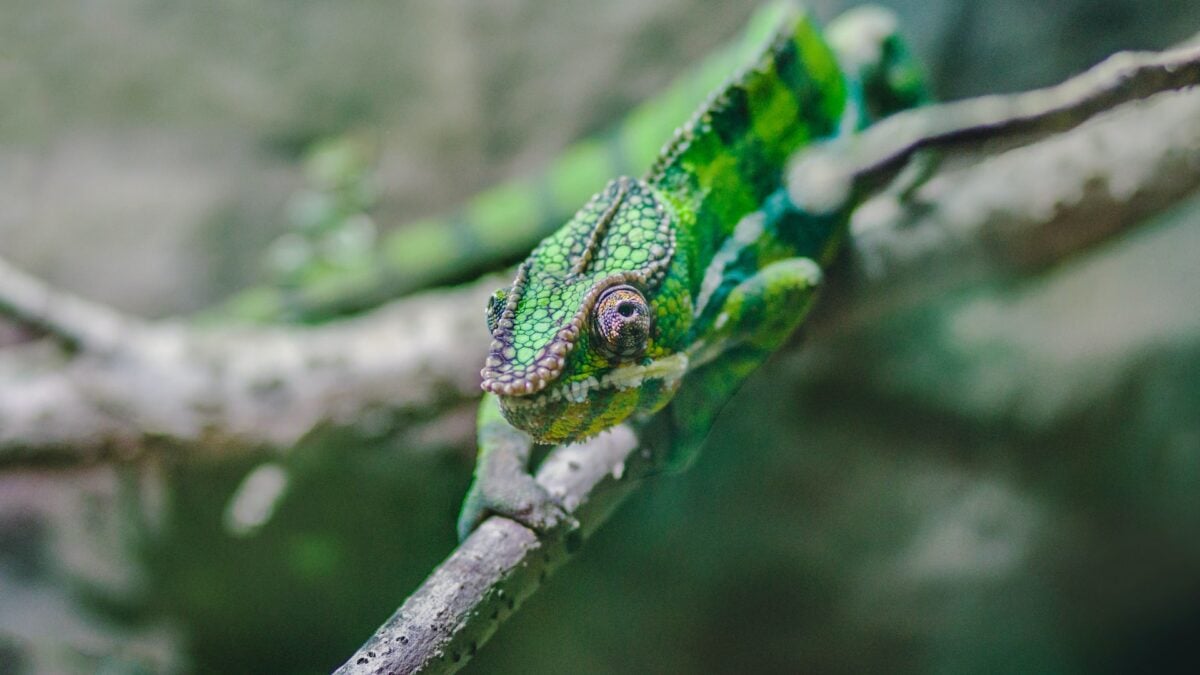
Belanda Chameleon, or Furcufer Belalandaensis, is declared to be the rarest chameleon to exist on earth. Their presence is strictly limited to the Belanda region in Madagascar. In order to save the species from further damage, serious preservation steps are being taken.
Venomous Varieties
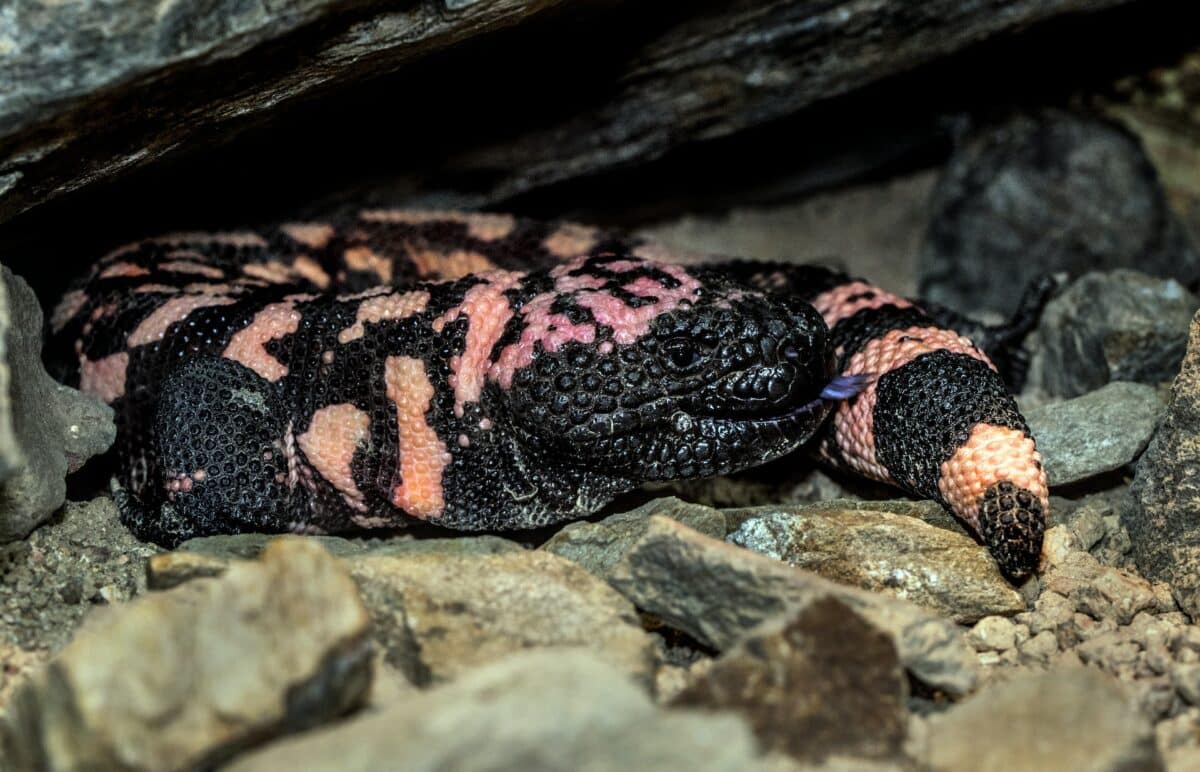
Out of all the known types of lizards, only three species are found to be clinically poisonous, namely, the Komodo Dragon, Mexican Beaded Lizard, and the Gila Monster. The western coast of Mexico is the home to Beaded Lizards, whereas the Gila Monster is found in the southwestern US and northern Mexico.
According to popular mythical beliefs, the two pre-stated lizards were notorious for causing severe injuries with their bites, yet there exists no reliable record of actual human fatality.
The research and studies done with Komodo Dragons have also revealed the fact that they are, in reality, venomous. The Indonesian islands of Komodo, Flores, Rinca, Padar, and Gili Motang are places inhabited by the huge species of Komodo Dragons.
Many species appear to be frightening or are mythically notorious but, in reality, do not physically harm humans in any capacity. The fear-mongering prevails and can only cease with education and research.
The Bottom Line
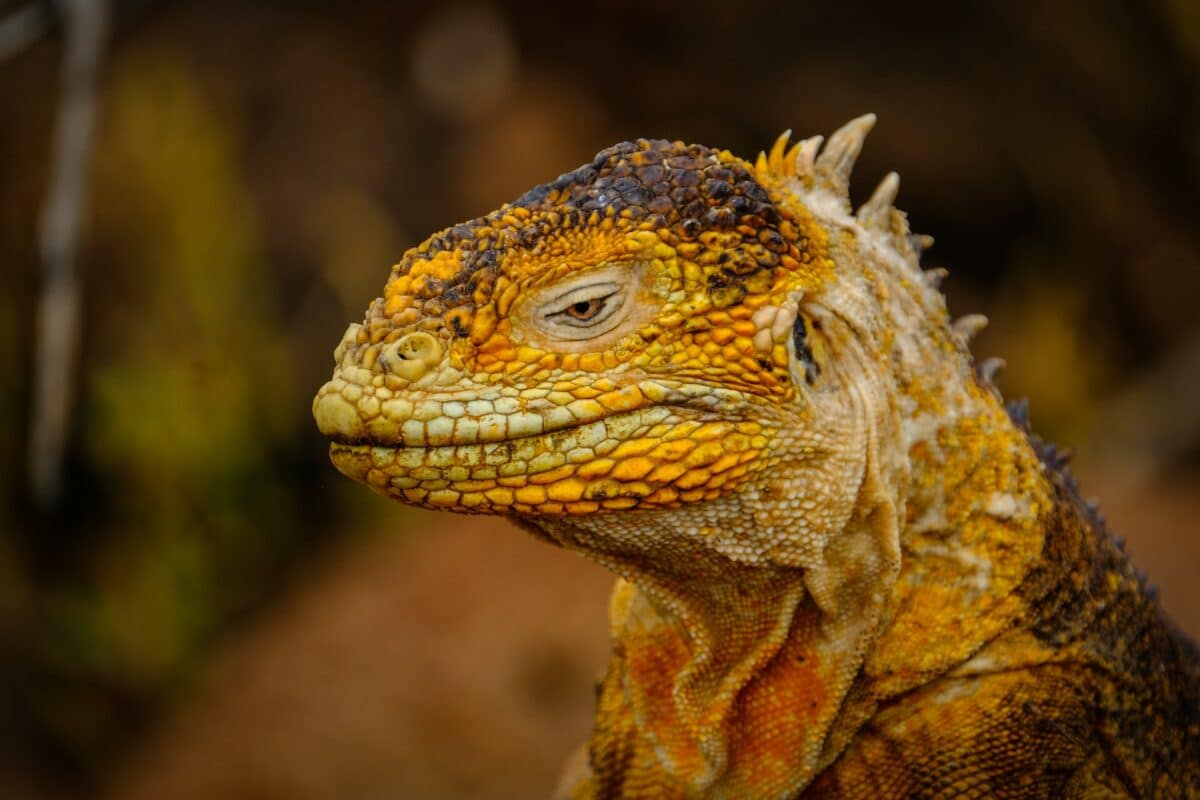
| Key Points |
| Lizards are reptiles and closely related to snakes |
| Lizards have around 6000 species on earth |
| Lizards have almost 40 diverse families |
| Lizards have scaly bodies with regeneratable pointed tails |
| Lizards survive on insects or small birds |
| Lizards are cold-blooded animals |
This detailed analysis and study of varied lizards is a condensed overview of the existing forms of lizards, discussing their commonly shared features and distinctive attributes. There are inarguably countless species of lizards, some of which are discovered and frequently encountered by people. At the same time, some still remain a mystery even for dedicated researchers.
A special mention of the endangered lizards is an attempt to promote habitat and animal preservation in order to save the ones that are left in very tiny numbers. We need to do much more to sustain the species’ continuance on Earth.
Thank you for reading this article on different types of lizards! As impressive as lizards are, the family of reptiles extends much further, take a look at All About Reptiles and Discover 4 Chameleons Who Give Live Birth.
- The Most Adorable Footage of Baby Wolves in Minnesota - April 15, 2024
- Man Teaches Bald Eagle to Play Fetch - April 15, 2024
- Mother Buffalo Tries to Save Baby From Komodo Dragons - April 14, 2024

